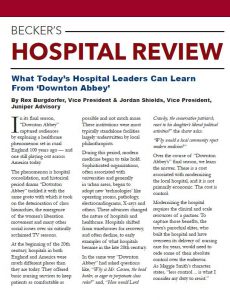What Hospital Leaders Can Learn From ‘Downton Abbey’
 In its final season, “Downton Abbey” captured audiences by exploring a healthcare phenomenon set in rural England 100 years ago — and one still playing out across America today.
In its final season, “Downton Abbey” captured audiences by exploring a healthcare phenomenon set in rural England 100 years ago — and one still playing out across America today.
The phenomenon is hospital consolidation, and historical period drama “Downton Abbey” tackled it with the same gusto with which it took on the deterioration of class hierarchies, the emergence of the women’s liberation movement and many other social issues over six critically acclaimed TV seasons.
At the beginning of the 20th century, hospitals in both England and America were much different places than they are today. They offered basic nursing services to keep patients as comfortable as possible and not much more. These institutions were most typically standalone facilities largely underwritten by local philanthropists.
During this period, modern medicine began to take hold. Sophisticated organizations, often associated with universities and generally in urban areas, began to adopt new ‘technologies’ like operating rooms, pathology, electrocardiograms, X-rays and others. These advances changed the nature of hospitals and healthcare. Hospitals shifted from warehouses for recovery, and often decline, to early examples of what hospitals became in the late 20th century.
In the same way “Downton Abbey” had asked questions like, “Why is Mr. Carson, the head butler, so eager to perpetuate class roles?” and, “How would Lord Crawley, the conservative patriarch, react to his daughter’s liberal political activities?” the show asks:
“Why would a local community reject modern medicine?”
Over the course of “Downton Abbey’s” final season, we learn the answer. There is a cost associated with modernizing the local hospital, and it is not primarily economic. The cost is control.